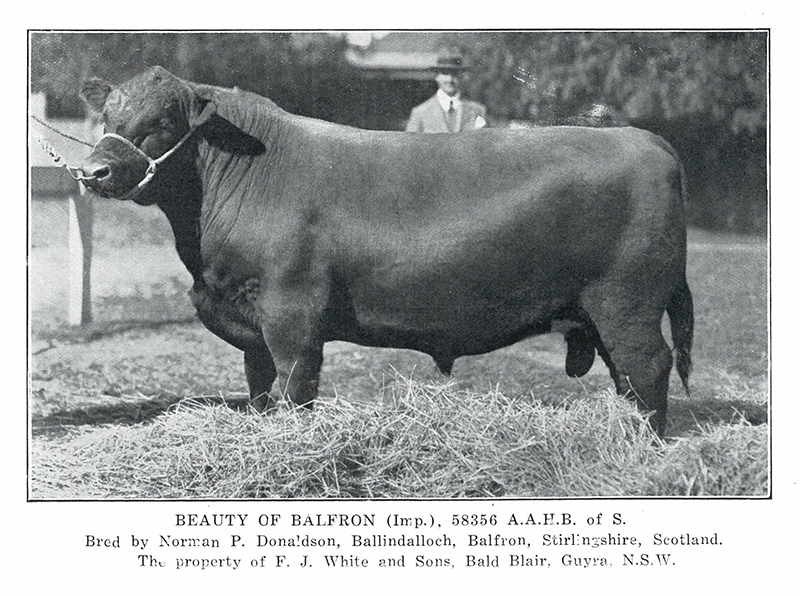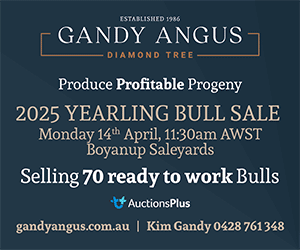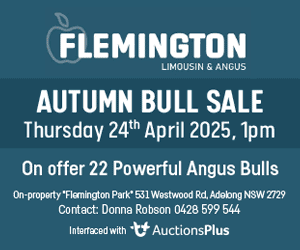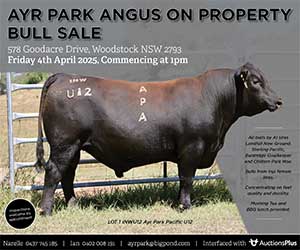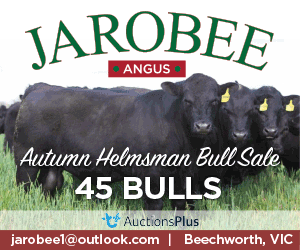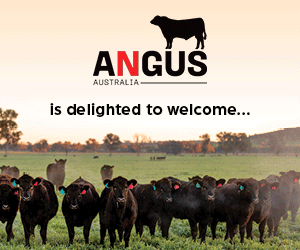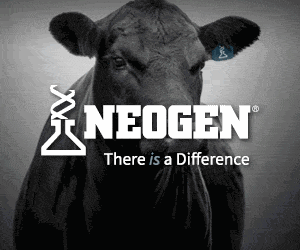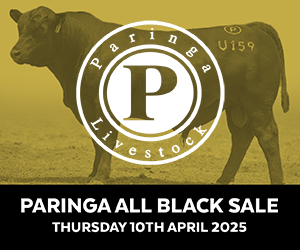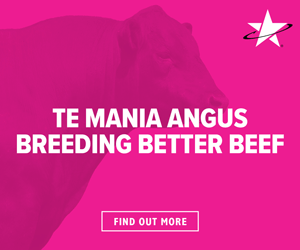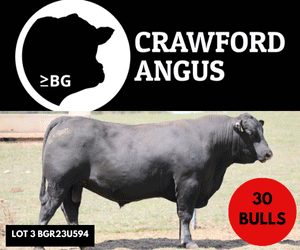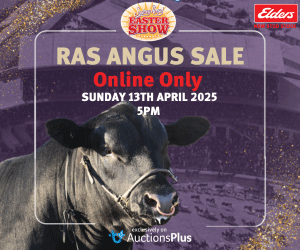The Aberdeen-Angus Herd Book Society was founded in Brisbane on the twelfth day of August 1918, by a group of Queenslanders, George Clarke from East Talgai, Macintosh Charles from the Gootchie Stud and RS Maynard.
The aim penned in the society’s first meeting was ‘forming a society for the preservation of pedigrees’. It wasn’t until a second meeting on May 9, 1919 that the society formally materialised, with an aim “for the promotion of the best interests of importer, breeders and owners of Aberdeen-Angus cattle, and thereby the public generally”.
The first recorded list of members of the society, as of July 1922 consisted of 14 members (or families). These pioneers were: W.M Charles, John Chisolm, George Clark, Albert Cook, George Dair, Hubert Docker, Adam Elder, Norman Forster, W. Jackson, J.A McIntosh, A. Payne, S. Tulloch Scott, the White Brothers of Edinglassie (J.C White), and F.J White and Sons of Bald Blair.
The Angus Pioneers
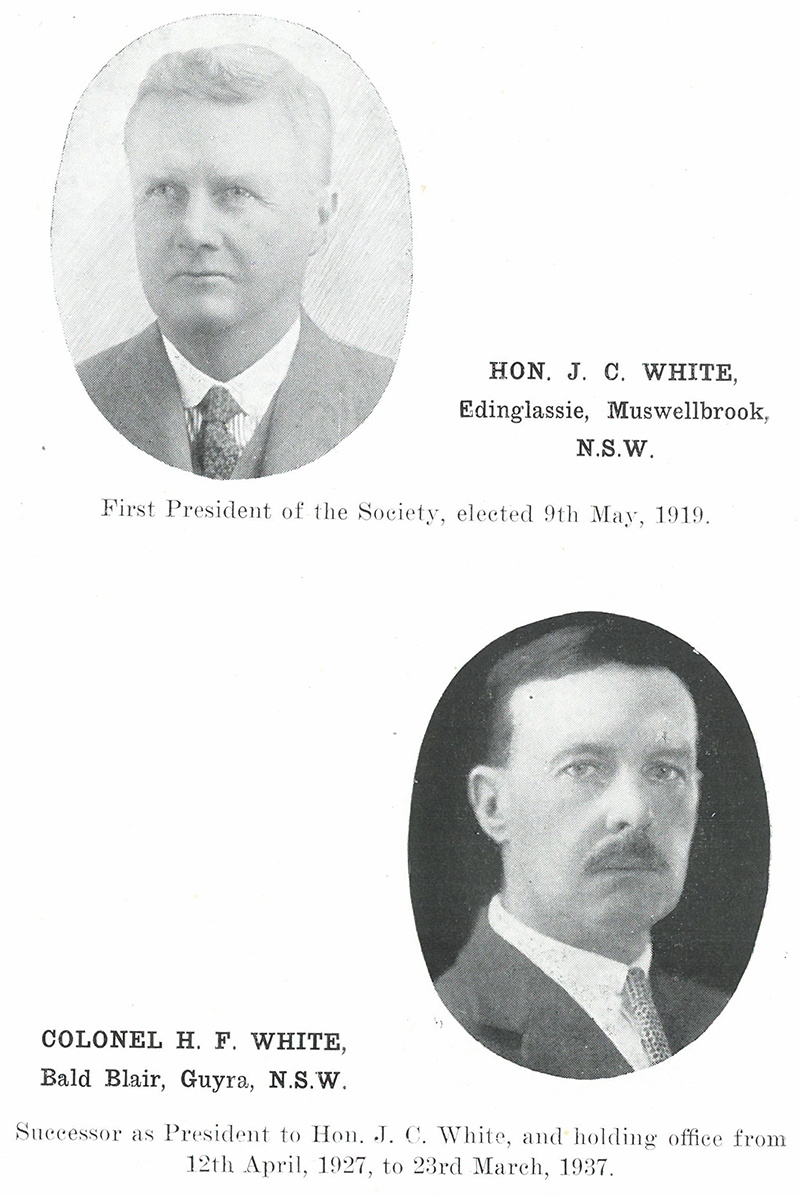
Prominent pioneers of the Angus breed during the early days of the society were James Cobb White (JC) of Edinglassie, Col. Harold White from Bald Blair, Norman Forster from Abington, Hubert Docker from Bontharambo and George Clark from East Talgai.
JC White was the first president of the Aberdeen-Angus Society and had an influential impact to the breed during its establishing years. It was said at the time of his death in 1827 that his governing as the leader of the society, his acquisition of cattle for the Edinglassie property, and his continued purchases and importation of high class bulls assisted in the continued growth of the Angus breed within trying times in its early breed development.
JC White’s nephew, Colonel Harold F (HF) White was instated as President of the society after the passing of his uncle. Hailing from Bald Blair, Colonel White become the longest serving President, serving in the role for a decade.
In his day, Colonel White was one of the most influential breeders of Aberdeen-Angus cattle due to his show ring and performance cattle. He is also hailed as one of the leading pioneers of performance recording for Aberdeen-Angus cattle. The White Family over the course of 100 years have continued to be prominent figures within the society.
Norman Forster was the society President from 1939-1941. The United Kingdom’s society had shipments of Aberdeen-Angus cattle delivered to Australia between 1927-1934, with the first shipment of five bulls in 1927, the second of nine bulls and fifteen females in 1933 and third shipment of three bulls and twelve heifers in 1934. Colonel White and Forster were some of those who purchased these cattle. During his involvement in the society Forster was approached by the Aberdeen-Angus Cattle Society of Scotland, regarding collecting Australian history of the breed.
As a producer, Forster and his family were among those who invested in the inclusion of New Zealand Aberdeen-Angus cattle after World War l.
Another founding member of the society Albert Cook from Greenmount, Queensland was also buying cattle from New Zealand at this time. Based in the Mackay region in Queensland, Cook is credited to have introduced the breed to the North Queensland coastal region, establishing his stud in 1917.
George Clark of East Talgai played a big part in the early establishment of the society and expanding the Angus influence in Southern Queensland. He founded his stud in 1915, buying cattle from New Zealand and Tasmania.
John Chisholm of Wantalanya, Winton was another founding father of the society that hailed from the northern regions of Queensland. His large stud ran cattle bought from New Zealand, Queensland and Victoria and was a large supplier of bulls for Queensland producers, which has been credited as influential in the expansion of the breed in the state.
Macintosh Charles, Gootchie, Queensland, was a fellow founding father and had five bulls and four cows registered in the first published Society herd book in 1922. He also had fifteen cows that the society deemed pure bred. He established his stud in 1914 from Balgownie cows bred by William Hogarth, who was the owner of the first stud developed in Queensland.
JA. McIntosh of Yundah, Mountside via Warwick is recorded to have imported New Zealand Aberdeen-Angus for his established stud from 1916.
W. Jackson, North Eton, Mackay was an original member of the Society at the publishing of the first herd book and while at this time had only one cow and two bulls registered with the Society, his involvement in the development of the breed assisted in the Society to become what it is today.
It was noted by Maynard in the 1920 Aberdeen-Angus Review that “Queensland has more Aberdeen-Angus breeders than any other state, Tasmania probably coming next and New South Wales third.”
George Dair of the Meadowbank Stud, Lilydale Victoria was also a founder of the Society. Dair developed his stud with the purchase of a heifer and three cows at the dispersal of the Barrowville herd in Tasmania in 1919. Meadowbank showed the only Aberdeen-Angus cattle at the Royal Melbourne Show in 1919, and was the first of the breed to be showed at the show since 1912. The females showed won all the main awards of the Royal Melbourne show in 1920 and 1921, and the stud was the solo entrants Aberdeen-Angus classes in 1922.
Hubert S Docker was another of the founding members of the Society. Docker was owner of Bontharambo, Wangaratta, Victoria. He started his stud after the conclusion of World War I using cattle sourced from Hayston Farms, Angus, Scotland.
Two Bulls with prized bloodlines imported by Docker were shown at the Royal Melbourne Show in 1920 and 1921, taking the champion and reserve champion both years. Docker has been attributed to assisting the popularity of the breed in the southern states due to his successes at Royal Melbourne Show, particularly the stud’s fat steers. It is recorded that by the year 1946, Bontharambo’s herd was likely the largest registered Aberdeen-Angus herd in Australia.
S. Tulloch Scott of Dunedin, Tasmania registered one bull and twenty six cows, one registered by the Society as pure bred, in the first herd book in 1922.
Founding member Adam Elder was behind the first established Aberdeen-Angus stud in Western Australia, Teviotdale, Moulyinning established in 1922. Elder had been importing the breed from Scotland between 1911-1916.
Forging Ahead

In 1927, top figures among the 6 bulls from a consignment that arrived from Scotland and landed in Sydney were 825 guineas paid by L Forster, ‘Abington’ Armidale NSW for Banker of Castlecraig (above) and the same for Beauty of Balfron by FJ White and Sons ‘Bald Blair’ Guyra NSW (top image). The importance of the transaction cannot be over-estimated as it was from this point the Society began to make real progress. From the Aberdeen Angus Manual compiled by the Angus Society Committee in 1949.
The first 25 years of the society was extremely important in the future development for the breed. Studs were developing, and the pure Aberdeen-Angus pedigree was blooming to fruition amongst producers.
After the materialisation of the Society and the publishing of the first herd book in 1922, Australia was struck by the Depression, however it was in these years that there an influx of Aberdeen-Angus cattle within Australia.
While Aberdeen-Angus cattle had a difficult start when first introduced to Australia, due to the prejudices they faced because of producers preference for other English breeds, it was the influences of Angus pioneers, including the founding figures of the society itself that drove the breed.
Many of these founding figures have decedents that are still serving as Angus leaders in the breed today. After the end of the first World War, black polled animal numbers were on the increase.
While the 1930s saw the expansion of Angus into the Northern Territory, it is recorded that due to the fact that there were a lack of meatworks or train link in or to Darwin to service in the NT that it hindered the plans of conversions of large cattle properties running other British breeds to Aberdeen-Angus and the stability of the meat industry in the state. According to Norman Forster, this was a “Truly national loss with the Aberdeen-Angus breed one of the greatest potential losers”.
In the 1940s, there was a boom within the US export market for hamburger meat. This opened new potential for Aberdeen-Angus producers, as prior to this point much of all import and export had been to the United Kingdom.
The first 25 years of the society are a credit to its presidents, Hon JC White (1919-1927), Col. HF White (1927-1937), Andrew Reid (1937-1939), Norman Forster (1939-1941), Lt. GT Reid (1941-1943) and Clifford Minter (1943-1944) and their committeemen during this time. The herd books published over this time are a testament to the gradual increase in the popularity of the brand over the course of the first quarter of the Angus century.

